Mysore Palace
| Mysore Palace | |
|---|---|
| ಮೈಸೂರು ಅರಮನೆ | |
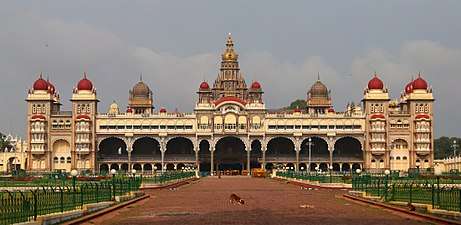 Mysore Palace | |
 Location within Karnataka | |
| General information | |
| Architectural style | Indo-Saracenic |
| Location | Inner Mysore |
| Town or city | Mysore |
| Country | India |
| Coordinates | 12°18′14″N 76°39′17″E / 12.3039°N 76.6547°E |
| Current tenants | Government of Karnataka |
| Construction started | 1897 |
| Completed | 1912 |
| Owner | Maharani Pramoda Devi Wadiyar |
| Design and construction | |
| Architect | Henry Irwin |
| Designations | Royal Seat of the Maharajas of Mysore |
| Website | |
| https://mysorepalace.gov.in | |
Ambavilas Palace (Kannada: ಅಂಬಾ ವಿಲಾಸ್ ಅರಮನೆ), otherwise known as the Mysore Palace (Kannada: ಮೈಸೂರು ಅರಮನೆ), is a historical palace and a royal residence at Mysore in the Indian State of Karnataka. It is the official residence of the Wadiyar dynasty and the seat of the Kingdom of Mysore. The palace is in the centre of Mysore, and faces the Chamundi Hills eastward. Mysore is commonly described as the 'City of Palaces', and there are seven palaces including this one; however, 'Mysore Palace' refers specifically to this one within the Old Fort.
The land on which the palace now stands was originally known as puragiri (literally, citadel), and is now known as the Old Fort. Yaduraya built the first palace inside the Old Fort in the 14th century, which was demolished and constructed multiple times. The current structure was constructed between 1897 and 1912, after the Old Palace was burnt ablaze.
Mysore Palace is now one of the most famous tourist attractions in India, after the Taj Mahal, with more than 6 million annual visitors.[1]
Construction
The last palace, now known as the Old Palace or the Wooden Palace, was burnt into ashes during the 1896 Dasara festivities. Maharaja Krishnaraja Wodeyar IV and his mother Maharani Kempananjammanni Devi, commissioned the British architect Lord Henry Irwin to build a new palace.[2] Meanwhile, the royal family stayed in the closeby Jaganmohan Palace. The construction was overseen by B. P. Raghavulu Naidu, an executive engineer in the Mysore Palace division. He had conducted elaborate architectural studies during visits to Delhi, Madras, and Calcutta, and these were used in planning for the new palace. The construction cost was placed at Rs 41,47,913 (around $4 million adjusted to inflation) and was completed in 1912.[3][4]
The palace was further expanded in around 1940 (including the addition of the present Public Durbar Hall wing) during the reign of Maharaja Jayachamarajendra Wadiyar. Although the construction was completed in 1912, the fort continued to be beautified and its inhabitants were slowly moved to the newer extensions built off the palace.
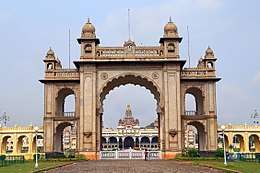
Mysore Palace main approach
Architecture
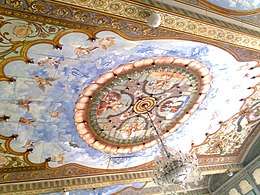
The architectural style of domes of the palace is commonly described as Indo-Saracenic, with blends of the Hindu, Mughal, Rajput, and Gothic styles. It is a three-story stone structure with marble domes, and has a 145-foot five-story tower. The palace is surrounded by a large garden. The entrance gate and arch hold the emblem and coat of arms of the kingdom of Mysore, around which is written the kingdom's motto in Sanskrit: "न बिभॆति कदाचन" (never terrified).
The main complex is 245 Ft in length and 156 Ft in width. There are fire extinguishing machines located in all parts of the palace in order to prevent any fires.[5] The palace has three entrances: the East Gate (the front gate, opened only during the Dasara and for dignitaries), the South Entrance (for public), and the West Entrance (usually opened only during the Dasara). In addition, there are numerous secret tunnels from the palace cellar leading to Srirangapatna, other palaces, and confidential areas.
The three-story stone building of fine grey granite with deep pink marble domes has a facade with several expansive arches and two smaller ones flanking the central arch, which is supported by tall pillars. Above the central arch is a sculpture of Gajalakshmi, the Goddess of wealth, prosperity, fortune, and abundance with her elephants. There are three major exclusive temple buildings within the Old Fort, and about 18 inside the palace heart building. The palace was built adjacent to the even older Parakala Mutt headquarters, whose leaders have remained the rajagurus (royal teacher and guide) of Mysore kings. The kings of Mysore were devotees of Goddess Chamundi, hence the palace's facing the Chamundi Hills.[6]
The palace houses two durbar halls (ceremonial meeting halls of the royal court) and incorporates an array of courtyards, gardens, and buildings.

Unique rooms
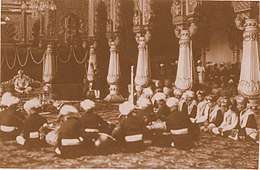
The palace is an excellent combination of Indo-Saracenic architecture and features several major unique rooms:
The Golden Throne
The Golden Throne was the royal throne of the rulers of the Kingdom of Mysore. It is one of the main attraction of Mysore Palace. It is kept for public viewing only during Dasara festival and on the rest of the days, it is dissembled and kept in safe lockers of the palace.
The Ambavilasa (Darbar -e- Khas or Private Hall)
This room was used by the king as a hall for private audiences. Entry to this opulent hall is through an elegantly carved rosewood doorway inlaid with ivory that opens into a shrine dedicated to Ganesha. The central nave of the hall has ornately gilded columns, stained glass ceilings, decorative steel grills, and chandeliers with fine floral motifs, mirrored in the pietra dura mosaic floor embellished with semi-precious stones. This is where the king would confer with his ministers. It was the chamber in which he gave audience to people deserving special attention.
Doll's Pavilion (Gombe Thotti)
Entry to the palace is through the Gombe Thotti, or Doll’s Pavilion, a gallery of traditional dolls from the nineteenth and early twentieth centuries. The pavilion also houses a fine collection of Indian and European sculpture and ceremonial objects, including a wooden elephant howdah (frame to carry passengers) decorated with 84 kilograms of gold.
The Kalyana Mantapa
The Kalyana Mantapa, or marriage hall, is a grand, octagonal-shaped pavilion with a multi-hued stained glass ceiling with peacock motifs arranged in geometrical patterns. The entire structure was wrought in Glasgow, Scotland.
The floor also displays a peacock mosaic, designed with tiles from England. Oil paintings illustrating the royal procession and Dasara celebrations of bygone years are displayed on the walls.
Other rooms
The palace houses several rooms of importance. These include:
- The Diwan-e-aam, a public durbar where the general population could meet the king at scheduled times to submit petitions.
- An armoury which contains arms used by the members of the royal family. It contains lances, cutlasses, and other 14th century weapons as well as those used in the early twentieth century, such as pistols.
Temples
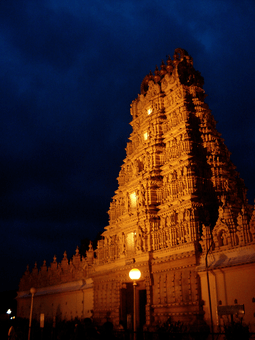
The palace complex includes twelve major Hindu temples. The oldest was built in the 14th century, while the most recent was built in 1953. Some of the famous temples are:
- Lakshmiramana Temple, dedicated to Lord Vishnu
- Someshvara Temple, dedicated to Lord Shiva
- Shwetha Varahaswamy Temple, dedicated to Lord Varahaswamy, one of the 10 incarnations of lord Vishnu
- Sri Prasanna Krishna Swami Temple, dedicated to Lord Krishna
- Sri Bhuvaneshwari Temple, dedicated to Goddess Bhuvaneshwari
- Kodi Someshwaraswami Temple, dedicated to Lord Shiva
- Sri Gayatri Temple, dedicated to Goddess Gayatri
- Sri Trineshwara Temple, dedicated to Lord Shiva
Acquisition
Currently, a major portion of the palace is under the control of the Government of Karnataka, acquired by passing the Mysore Palace Acquisition Act in 1996 during the H. D. Deve Gowda-J. H. Patel state assemblies. Only a small portion of the palace, towards the West Gate, is under the possession of the royal family, Maharani Pramodadevi Wadiyar, to be precise. The Karnataka High Court had passed judgment in favour of the Maharaja Srikantadatta Narasimharaja Wadiyar, that the palace belongs to the royal family. However, the Government of Karnataka appealed the case to the Supreme Court after its defeat in the High Court. The case is still pending; the Maharaja, however, died on 10 December 2013, and did not survive to continue fighting against the government. His wife, Maharani Pramodadevi Wadiyar, is now the plaintiff.
Visitor information
The palace is 1.8 km (1.12 miles) from the central railway station to its west, 1.4 km (roughly 0.8 miles) from suburb bus-stand to its north-east, and 9.5 km (around 6 miles) from Mysore Airport, and in a small portion in its backyard is the city bus stand. The domestic airport is directly connected to the international airports of Bangalore, Chennai, Trivandrum, Hyderabad, Mangalore, and Bombay. The city is connected through the state highway SH-17.
- The Palace Light Illumination is on Sundays and all public holidays between 7 and 7:45 in the evening, and on all ten days during the Dasara.
- Sound and light programmes are arranged on all days between the same time, 7 and 7:45 in the evenings, except on Sundays and public holidays.
The Old Fort of the palace stands open from morning 10 to night 8 and is free of cost. Entry to the palace buildings is between 11 in the morning and 3 in the afternoon, under tight security. Two squads, one police and one paramilitary, stand guard during the day, and two more during night. Children below seven are free to enter the palace, while those between seven and twelve are charged Rs 25 per head. For adults, tickets are available for Rs. 50. Price of admission for foreign tourists is the same. Footwear are to be removed before entering the palace complexes.
A major issue for visitors is the frequent extortion of bribes from visitors and tourists from corrupt Police and Palace Guards. Several scams have been reported, like guards' befriending visitors, offering to take them to special places, and extort money. Visitors have reported other scams perpetrated by corrupt officials which include demands to produce tickets and further requesting bribes.[7]
Image gallery
- Architectural detail of Mysore Palace
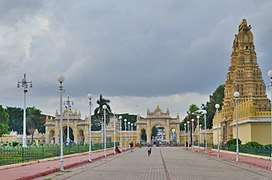 Mysore Palace North Gate
Mysore Palace North Gate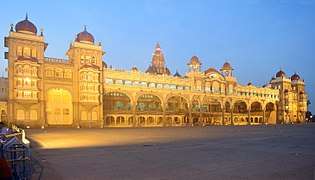 Mysore Palace during Blue Hour
Mysore Palace during Blue Hour Light up of Mysore Palace
Light up of Mysore Palace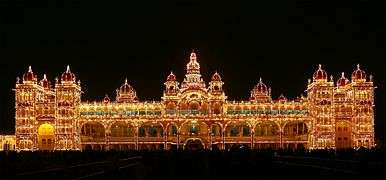 Mysore palace in the evening
Mysore palace in the evening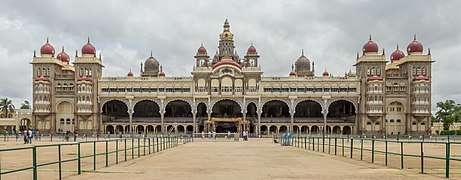 The Grand Mysore Palace
The Grand Mysore Palace night view of mysore palace
night view of mysore palace
See also
Apart from the leonine Mysore Palace, Mysore hosts seven other royal palaces.
- The Jaganmohan Palace, a temporary royal residence, was later used by Maharaja Jayachamarajendra Wadiyar as his art gallery and remains so.
- The Jayalakshmi Vilas Palace, now a folk art museum maintained by Mysore University, was used as one of its administrative offices
- The Rajendra Vilas Palace, now a private hotel atop Chamundi Hills, was used as guest palace by the Maharajas during their visit to the Hills
- The Lalitha Mahal Palace, now a five-star hotel, was used as palace for British envoys and governors
- The Cheluvamba Vilas Palace, now the headquarters of Central Food Technological Research Institute, a national research institute, was donated by Maharaja Jayachamarajendra Wadiyar donated to the Union of India
- The Krishnarajendra Vilas Palace (now Krishna Rajendra Hospital).
In all the above palaces, the royal family holds blocks held by the kings traditionally. However, the Bangalore Palace is entirely in the possession of the royal family. Bangalore Palace remains entirely a private property of Maharani Pramoda Devi Wadiyar.
Besides these are buildings a century old or more, like Crowfard Hall, now the headquarters of the University of Mysore; Oriental Research Institute, a Mysore University library; the Public Offices; the Corporation Offices of Mysore City Corporation, etc.
- List of Heritage Buildings in Mysore
- Culture of Mysore
- Laxmi Niwas Palace in Bikaner, Rajasthan
- New Palace, Kolhapur of the Bhonsle Chhatrapatis
- Jai Vilas Mahal, Gwalior of the Scindias
- Rajwada, Indore of the Holkars
- Shaniwar Wada, Pune of the Peshwas
- Thanjavur Maratha palace of the Bhonsles
References
- ↑ "Tourism in Mysore". 22 April 2014.
- ↑ "Maharaja's Palace". Mysore District. Retrieved 2014-02-17.
- ↑ http://www.culturalindia.net/monuments/mysore-palace.html {{|date=October 2017}}
- ↑ "Mysore palace will complete 100 years next year". Deccan Herald.
- ↑ Chamundi
- ↑ "One of the best palace in India - Review of Mysore Maharajah's Palace (Amba Vilas), Mysuru (Mysore), India - TripAdvisor".
External links
| Wikimedia Commons has media related to Mysore Palace. |
- Official virtual tour website of Mysore Palace
- Mysore Palace
- Official Mysore Dasara website
- Palaces of Mysore
- Mysore Palace lighting
Coordinates: 12°18′14″N 76°39′16″E / 12.30389°N 76.65444°E